The Arturia MiniBrute 2 could easily be chosen “People’s-Analog-Synthesizer Number ONE of the decade”. It certainly has all the refinements that a modern versatile analog synth should have. But in truth, its award may be out of reach, since the market is going through an odd phase of inflation at the moment.
W hile “Inflation” is indicative of money, we could coin the term “Synth-Flation” to explain what’s going on: The artificial expansion of the synth market. Foremost among the competitors, the MiniBrute 2, an excellent sounding 2-VCO synthesizer from the French synth manufacturer Arturia.
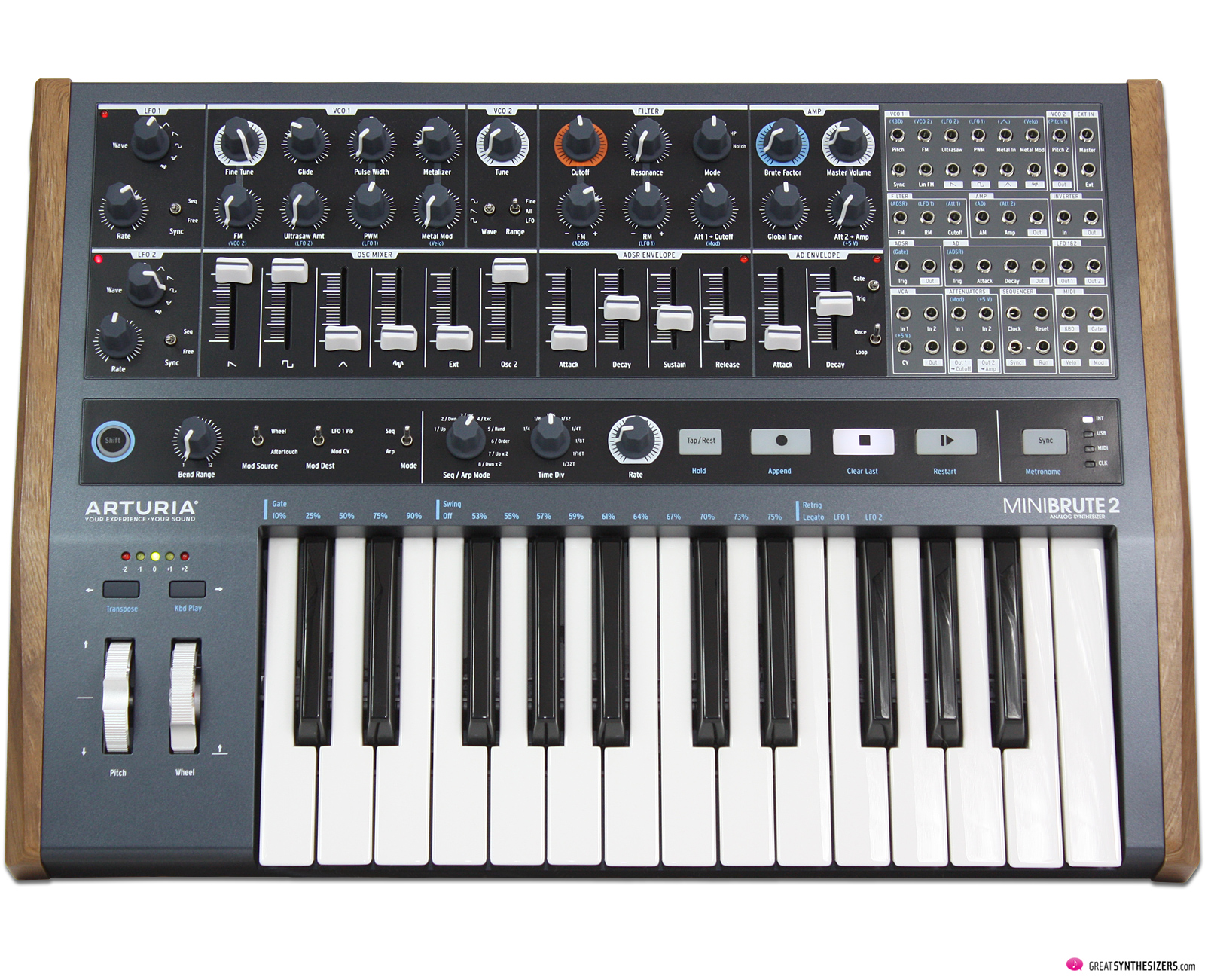
The fact is, if the market were dominated by the veterans of the category “Vintage Synthesizer”, the release of MiniBrute 2 would see masses of enthusiasts around the globe, stampeding to the music stores. They would desert their jobs, friends and family and jump on already overcrowded trains to get to cities where they could buy the MiniBrute 2 (or at least see their object of desire).
But that’s just not the way it’s happening …
After the original MiniBrute had experienced an entirely respectable output of production, after MicroBrute and MatrixBrute had been introduced into Arturia’s portfolio, and after many dozens of analog instruments of various producers had appeared on the market, MiniBrute 2 has become just one of numerous analog synths in 2019.
The fact that the MiniBrute 2 is selling well, but not in extraordinary quantities, the fact that it’s not a top-seller, so to speak, is a fate that the instrument suffers unfairly. Neither its excellent sound, nor its wonderful concept, nor its balanced price/performance ratio explain the fact that it hasn’t risen to the “People’s-Analog-Synthesizer Number ONE”. But whether things change for the better has yet to be seen. Without a doubt, Arturia has done everything right, and the MiniBrute 2 is indeed an almost perfect compact modern analog synth.
The MiniBrute 2’s three areas of excellence
The MiniBrute 2 concept involves 3 areas: Sound Engine (Synthesizer), Performance Area (Sequencer, Arpeggiator, Wheels) and the Interfacing Section (48-point patchbay plus the optional RackBrute System expansion).
Sound Engine
The synthesizer in short. MiniBrute 2 has:
- 2 oscillators / VCOs (with noise)
- 1 MultiMode filter / VCF
- 2 envelopes (ADSR and AD)
- 1 amplifier / VCA
- 2 LFOs
2 oscillators / VCOs
The main oscillator – VCO 1 – has been known since the original MiniBrute. Three waveforms can be mixed independently and there is noise as well as “external audio” input. All well-known qualities such as PWM, Metalizer or Ultrasaw can be found as well as the newly-added cross modulation – FM by VCO 2 (!).
The latter is much simpler than VCO 1. VCO 2 has a slimmed-down hardware design (a toggle switch to choose between waveforms instead of sliders for waveform mixing). And there is no PWM or other extra. But VCO 2 can be set to Low Frequency and thus be used as an extra LFO. And by chosing frequency range ALL you can sweep throughout the entire audio range with the turn of a knob – excellent! Finally, FINE tuning allows for beats and interval-adjustments.
1 MultiMode filter / VCF
The Arturia MultiMode filter offers LowPass, HighPass, BandPass and Notch. The associated ADSR envelope and modulation wheel are pre-wired to control the filter frequency, and LFO 1 is internally routed to filter resonance (RM – resonance modulation).
2 envelopes (ADSR and AD)
Besides the ADSR from the filter area, there’s an AD envelope in the VCA section. Although small in size, it offers quite a few extras (an interesting parallel to the minimalistic VCO 2). First and foremost the loop function, another great facet to the MiniBrute 2 in terms of modulation variety … the loop-AD in addition to LFO 1, LFO 2 and VCO 2 (which can – once more – be used in low frequency mode). But there is even more: Attack and Decay can be voltage-controlled (!) – the two related CV-inputs are found in the patch area.
1 amplifier / VCA
In addition to the above-mentioned AD envelope, the VCA options include that important (and Arturia-typical) BRUTE knob. A simple, yet effective function for output signal distortion. Then there’s GLOBAL TUNE … for overall pitch adjustments in the studio or on stage (or for detuning two MiniBrute 2 against each other, just as an example). The ATT 2 > AMP knob, by the way, opens the amplifier permanently – so you can program a sound with both hands.
2 LFOs
Each LFO offers 6 waveforms (including random stepped / random gliding). The frequency ranges from 0,0625 Hertz (one cycle every 16 seconds!) up to 100 Hertz (audio range). The SYNC switch sets the LFO rate’s operating mode – it can be synchronized to the Sequencer/
Arpeggiator (Seq) or set to FREE mode (free running LFO).
Performance Area
Unlike the original MiniBrute, the wheels are now placed “right next to” the keyboard. Which, of course, improves performance. And these are no cheap plastic-wheels, but solid aluminum wheels, slightly ribbed and a pleasure to operate. Pitchbend range can be adjusted to up to one octave, further increase of the audio range can be achieved by the key transpose function (+/- several octaves).
The Modulation Wheel (or – alternatively – Aftertouch!) can be used for LFO 1 modulation (“Vibrato”), and/or as a source for filter frequency modulation, or as a global CV-source in the patch-bay.
Sequencer and Arpeggiator are equipped with a variety of playing modes / directions, clock divisions, gate lengths and swing factors. The two latter functions are activated by means of the SHIFT function via the keyboard keys (see the terms in blue above the keyboard).
You can record eight different sequences, each with up to 64 steps and Sequ / Arp synchronization can be done internally, via USB, MIDI or via (analog) Clock.
At this point we have to mention the MiniBrute 2S. It has no standard keyboard, but 16 pressure- and velocity-sensitive pads that can be used as a keyboard or to program the sequencer. The expanded sequencer controls Pitch, Gate, Velocity and Pressure. While Seq 1 is for notes, Seq 2 and Seq 3 can generate other types of signals: Gates, CV, Pitch, LFOs, Envelopes. Real-time and step-editing are available. It’s amazing how flexible the MiniBrute 2S really is …
Interfacing Section
In addition to the usual INs/OUTs à la MIDI, USB and Audio, there’s a huge 48-point patch panel – THE highlight of MiniBrute 2.
“The MiniBrute 2 is an impressive synthesizer with a powerful set of analog circuitry […]. But with the addition of the patch bay the MiniBrute 2 ranks with modular synthesizers many times its size.” (Arturia, MiniBrute 2 User Manual, page 53)
Optimally located to the right of the user panel, the patchbay not only expands the MiniBrute 2’s (internal) sonic possibilities, but also opens to the world of (external) modular synths – both to vintage semi-modulars (ARP-2600, Roland System-100M, etc.) and to modern instruments / devices (Eurorack modules). And there are some extra extras as well: the patchbay includes an inverter and a cute MIDI-to-CV interface (with outputs for CV, Gate, VEL and MOD-wheel). Perfect!
Two small criticisms must uttered none the less. First, the patch panel labelling. It is as follows: blue printing (pre-wired connections) above the sockets, white printing (in/outputs) below. In the synthesizer section, however, all names are printed below the knobs, in 2 rows, white labelling on top, blue labelling at the bottom … which is just the other way round as in the patchbay area. It’s a bit confusing, no?
Second, there are no multiple sockets. Granted, the patch panel is very crowded. We could not tell where to put multiples. Nonetheless, some signal splitting is always necessary when it comes to wiring a patchbay, so we wonder why Arturia didn’t implement a dedicated multiples-area (2×3 and 1×4 multiples, for example).
In Practice
Those who believe that a modern analog synth has by nature limited sound potential are in for a surprise. Actually, just the opposite is true (whereby the topic of “sound character” must be debated somewhere else). The Arturia MiniBrute 2 is extremely versatile with excellent sound potential. The musician needs a very long time to even reach its musical peripheries. Peripheries that then can be pushed back (nearly) infinitely with the optional RackBrute Eurorack expansion.
What do we mean by “excellent sound”? MiniBrute 2 entirely fullfills the demands of analog sound art. Ok, ok … almost. We’ll get around to its few limitations later. The SOUND is well-balanced throughout the audio range. Powerful 2-VCO-sequencing, fat basses, silverly shimmering lead sounds with vibrato, spacy x-mod effect sound creations … what more could the heart desire? The musical workflow is enhanced by well-thought-out pre-wiring and performance options (e.g. vibrato-LFO and/or VCF-modulation by the mod-wheel) and many other details. Subtle beats, massive (Brute) saturations, spectacular filter sweeps … If you can imagine it, MiniBrute 2 has it!
[A little story on the side. A talented friend who regularly hears through my various synths tends to call out in surprise: “Wow, I could have used an instrument like this when I was young!” The only synth he could afford back in 1978 was the limited Korg 900PS – hardly the fullfillment of a musician’s dreams. Today, with the MiniBrute 2, our friend would have all the creative musical possibilities at his fingertips that he needed back then … be it in sound, be it in performance. A twist of fate … Imagie what he could have done with the MiniBrute 2 40 years ago!]
Now here might be a good place to place those couple of critical remarks. Admittedly, this is complaining at a high comfort level. Perfect is just not a proper requirement for an instrument … no synthesizer can satisfy everybody’s needs. But still …
First a couple of thoughts about the MultiMode Filter. Amazingly enough, all filter types sound similar at high resonance. That’s the way it was with the original MiniBrute, with the MicroBrute, and with the MatrixBrute. It is, so speak, the Arturia-Analog-Filter à la Steiner-VCF-Clone. So this is nothing new, but for the first time it has become clearly obvious to us that, whether you use BandPass, HighPass or Notch, at high resonance settings the sounds are all very much alike. Whereby especially with the Notch Filter a tiny feeling of disappointment may arise when comparing this with the strong notch filter character of other synth manufacturers (keyword: phasing). But that’s really no big deal.
What the MiniBrute 2 is indeed missing is a ring-modulator, for all those metallic sounds and sound effects. Obviously, the RackBrute system will help out here. Nothing is easier than adding an external ring-modulator (or other goodies of the Eurorack portfolio) to the MiniBrute 2.
But let’s talk about the RackBrute itself. Connected to the synth, it looks modern and very funky. Both units fold up nicely and can be carried around easily – the concept of this folding system is great. However – this is purely a subjective feeling – we think that the space between synth and firmly connected RackBrute is too small. To be specific: When operating the MiniBrute 2 knobs in the upper area (or when doing some patching in the CV-panel), the backs of your hands just get in the way of the above RackBrute modules (knobs, cables, whatever …). Which makes performing the coupled MiniBrute 2 / RackBrute system a little bit like running through obstacles. Tilting the RackBrute doesn’t change the manouverability at all.
So, a stand-alone, non-attached Eurorack system would be a more practical alternative. You loose the advantage of being able to fold MiniBrute 2 and the Eurorack unit together, of course, but in musical performance you gain the freedom of individual positioning of your setup.
All in all
We’d really wish the MiniBrute 2 the honour of becoming the “People’s-Analog-Synthesizer Number ONE”. It certainly fullfills all requirements: Excellent sound, performance on a grand scale, compatability with all Eurorack modules via CV-Panel and the RackBrute system (or any other Eurorack case). And all that for just a couple of hundred Euros.
But don’t forget the “Synth-Flation”, the order of the day. While many manufacturers vie for leadership as the best (cheapest?) clone of the Roland SH-101, while a wide range of analog synths (Boutique instruments, complete synth-modules in 3HE-format, the large Matrix concept) threaten to saturate the market, MiniBrute 2 waits patiently on the side lines for its big moment to come. Because MiniBrute 2 carries jokers in its hand: TRUE highest sound quality and TRUE perfect performance potential – in comparision to some of those other “genial” analog synths out there on the market.
x
Update 2022: Arturia launched the MiniBrute 2 / 2S Noir, a limited edition of the original MiniBrute 2, now with a black housing and black knobs.
x
We’ve added 30 minutes of audio material. Since the basic sound character of MinIBrute 2 is identical to the original MiniBrute, to the MicroBrute and MatrixBrute, we have slightly changed the focus of the sound samples and placed a second synth side by side with the MiniBrute 2: A good old Crumar Trilogy. A cheesy multi-keyboard equipped with CEM filters, still working flawlessly after decades of use (and/or storage). MiniBrute 2 and Trilogy: A poignant symbiosis.
Arturia MiniBrute 2 / 2S
Arturia MiniBrute 2 / 2S Noir (Limited Edition)
Monophonic Analog Synthesizer
with sequencer / arpeggiator
and patch field
Prices:
MiniBrute 2 Noir: approx. 500 Euros / USD
Limited Edition
MiniBrute 2S Noir: approx. 500 Euros / USD
Limited Edition
(01/2023)
Website Manufacturer:
www.arturia.com
Links:
Arturia MiniBrute Test Report
Arturia MicroBrute Test Report
Arturia MatrixBrute Test Report




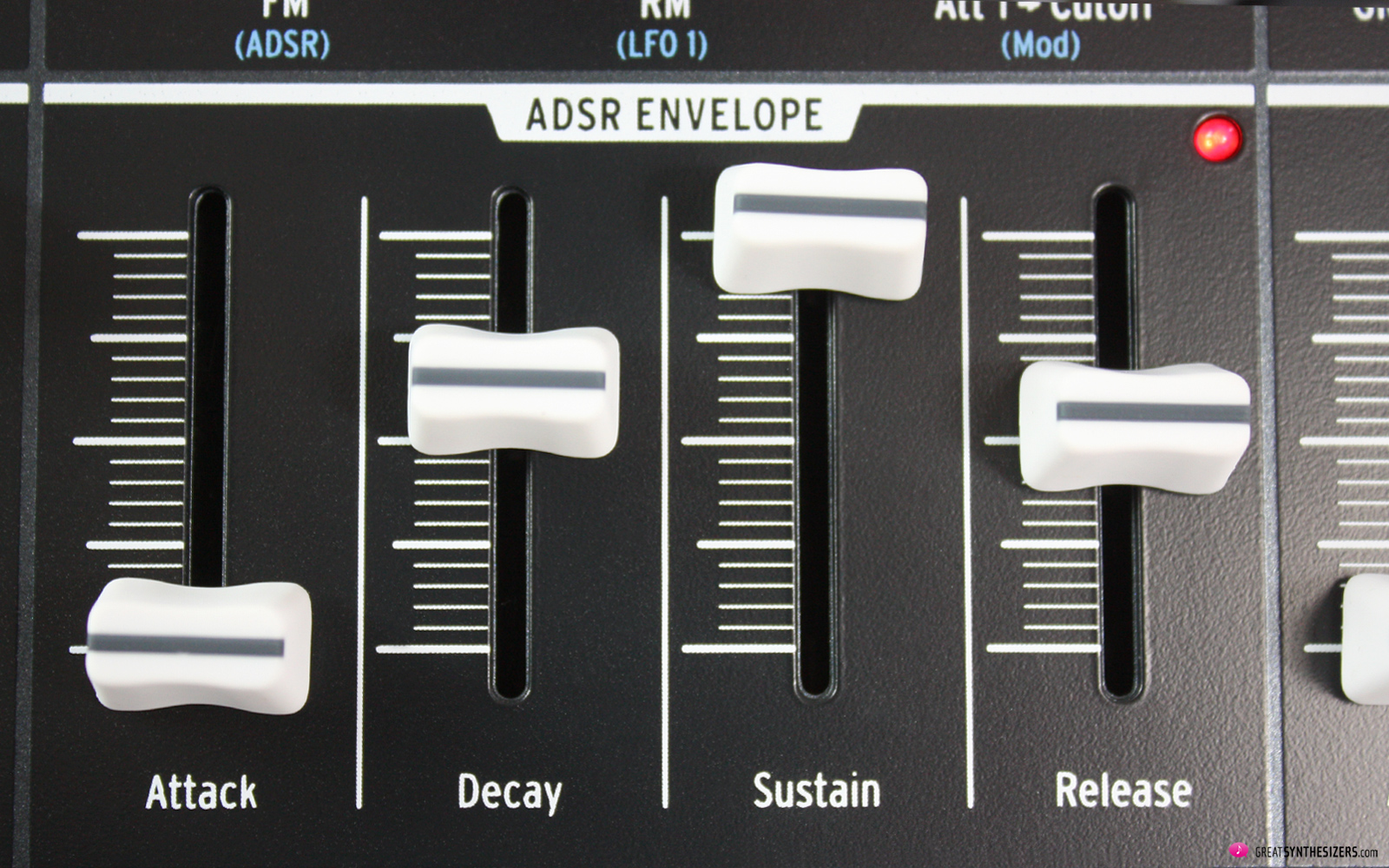
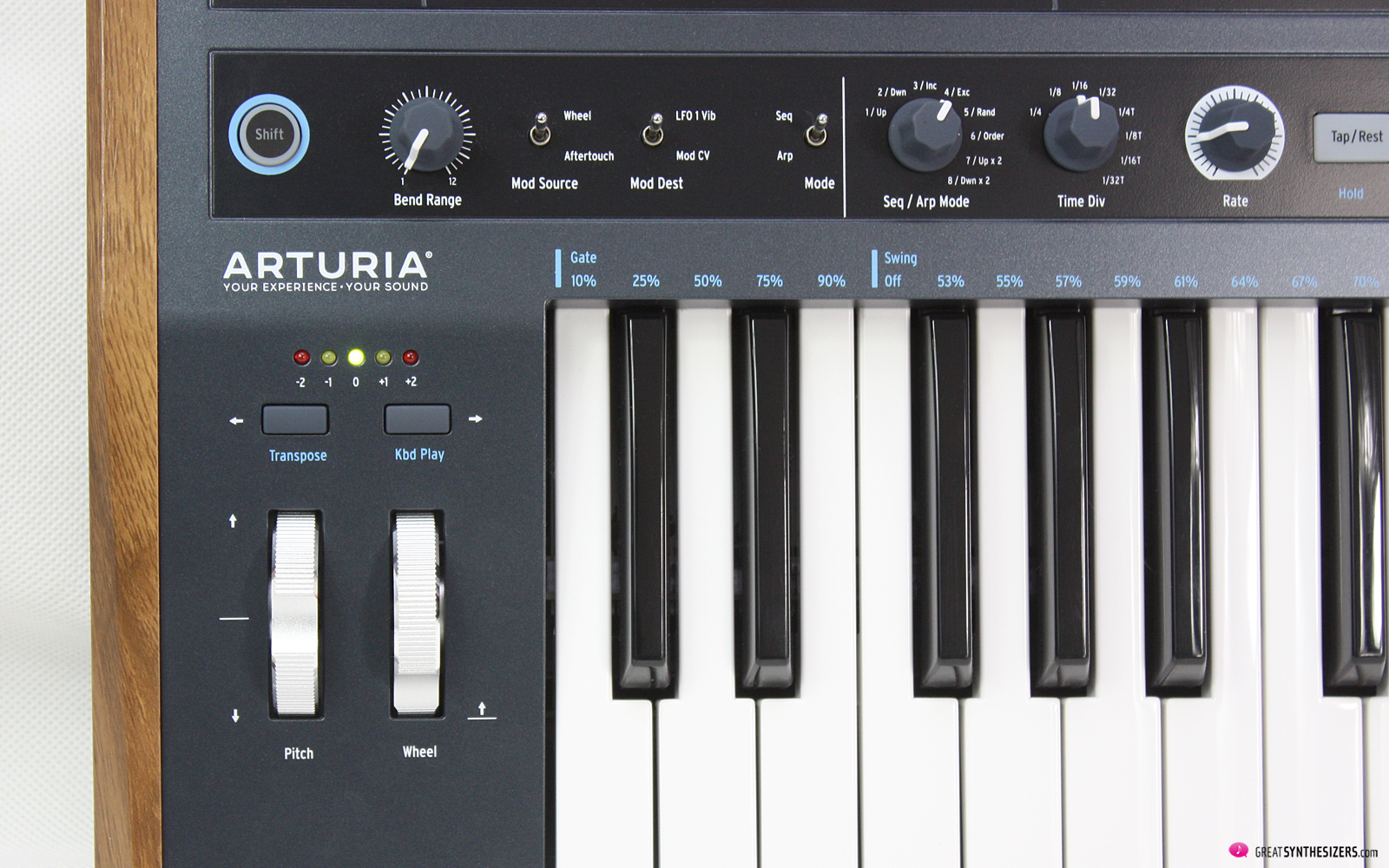

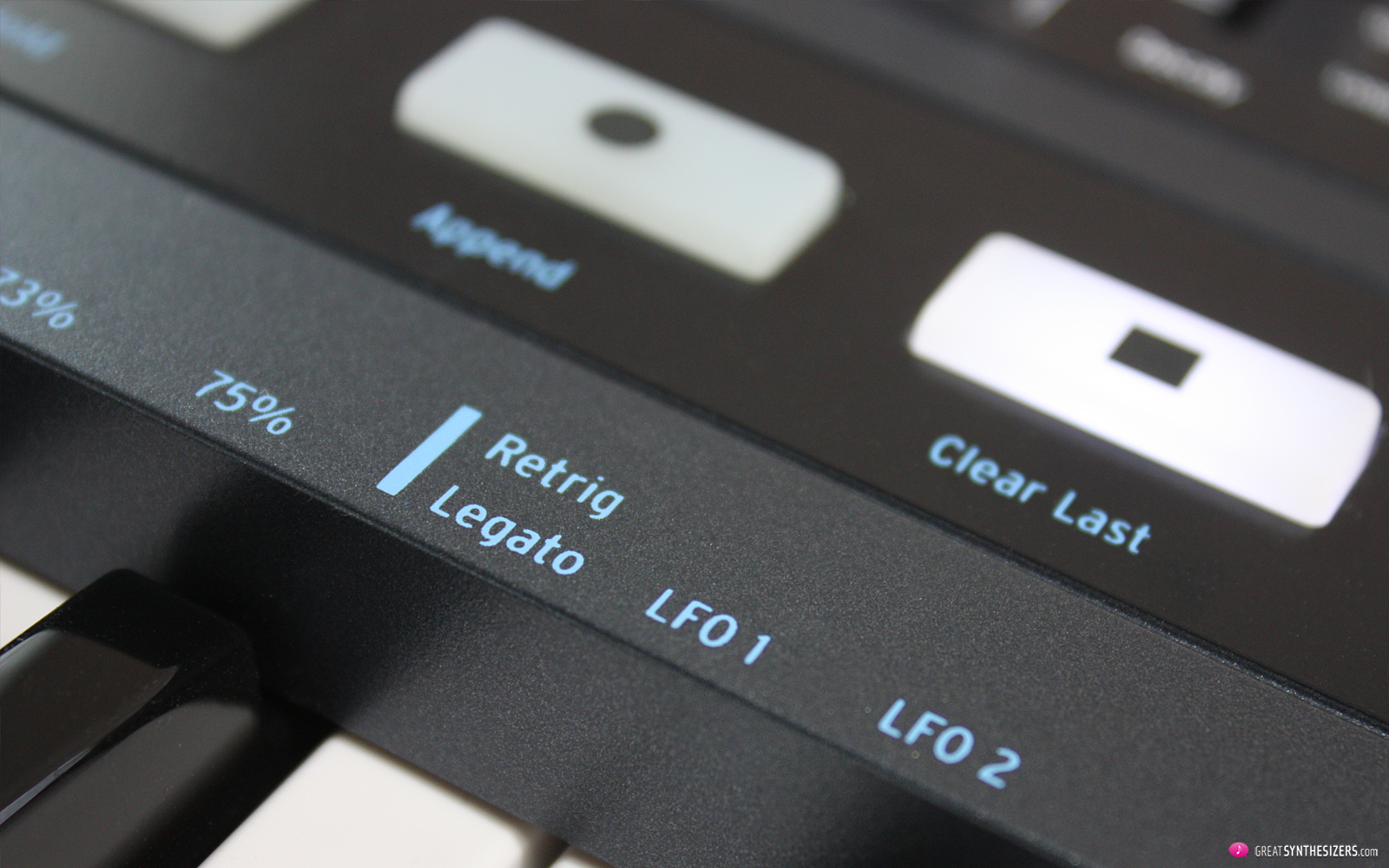

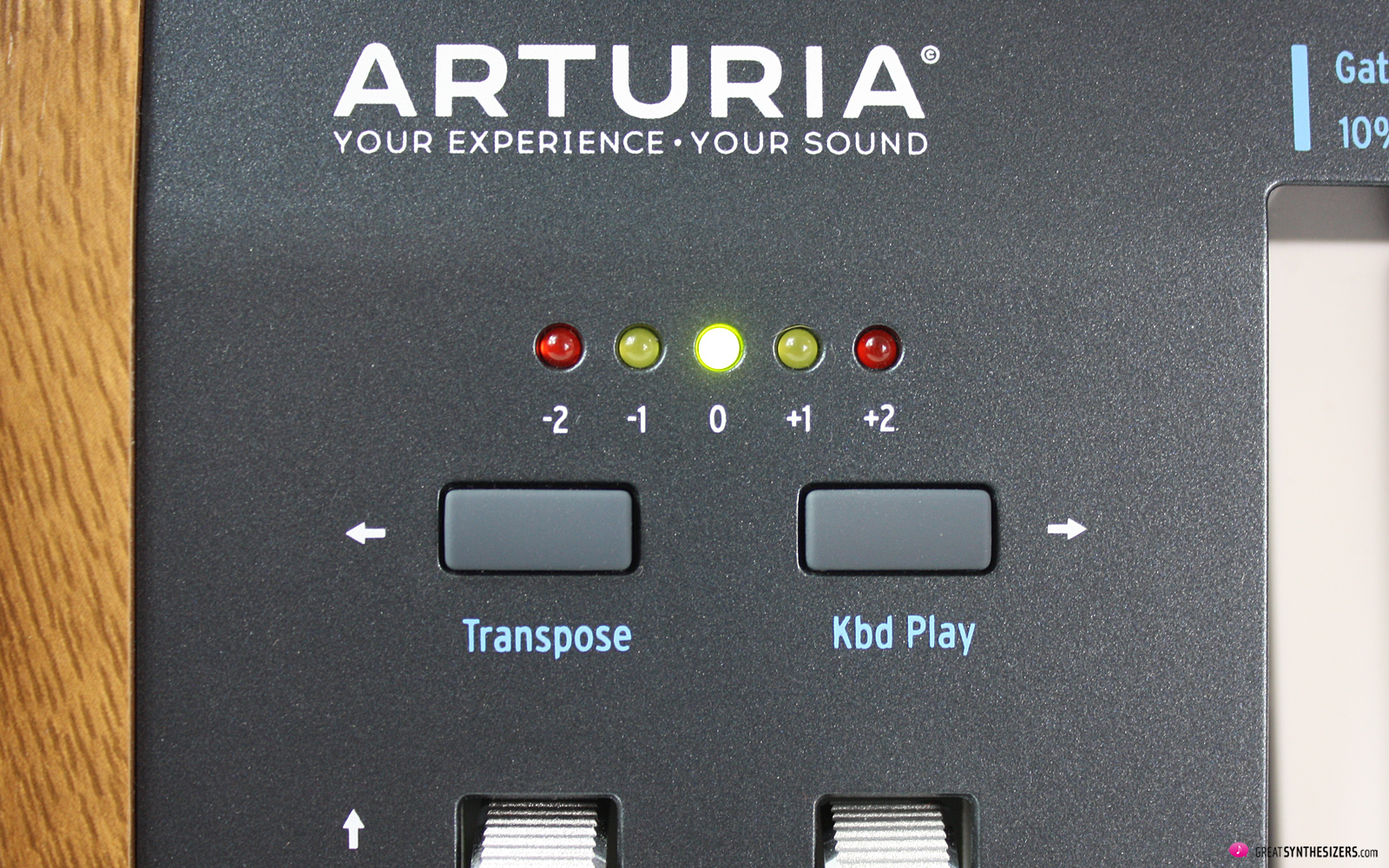
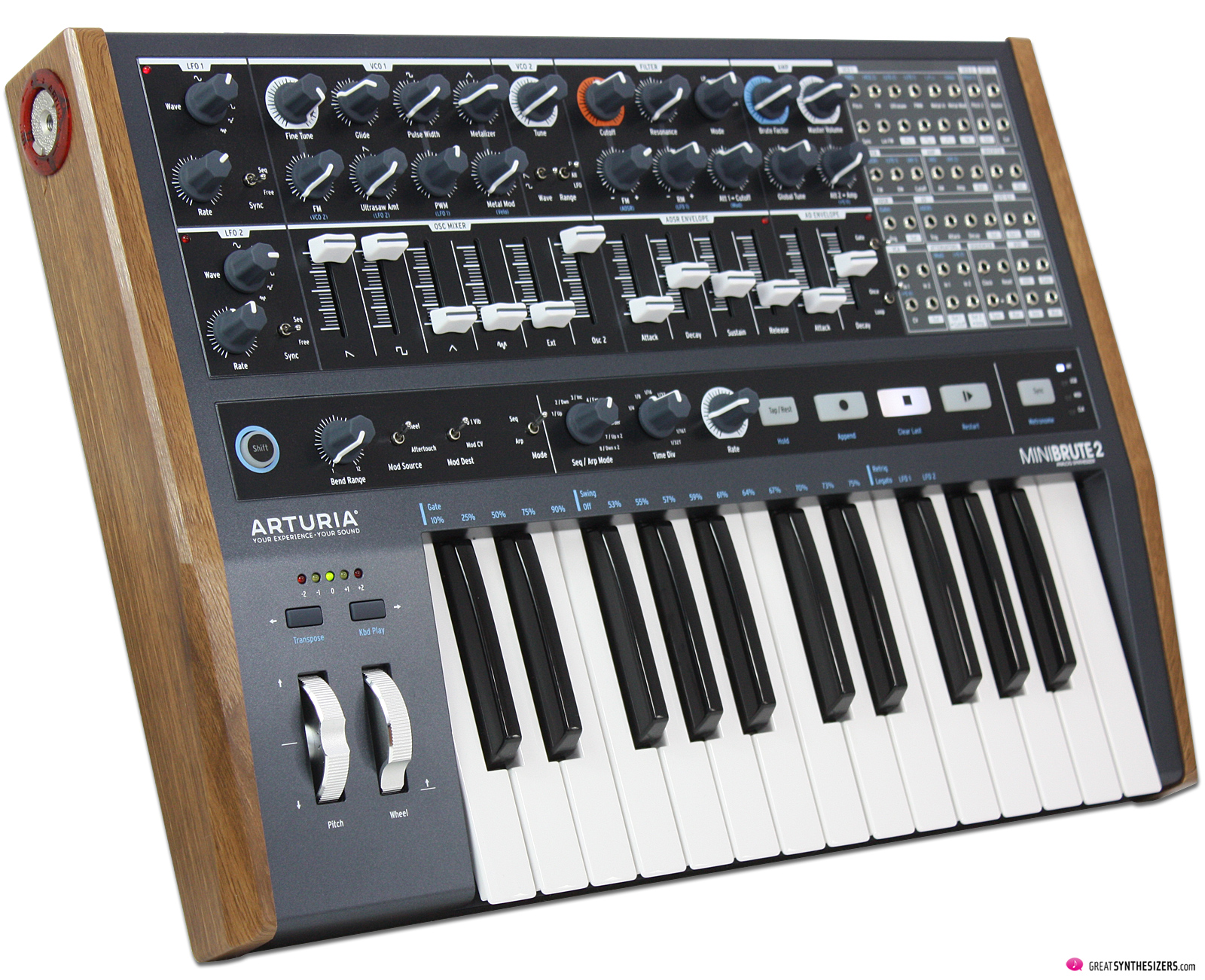
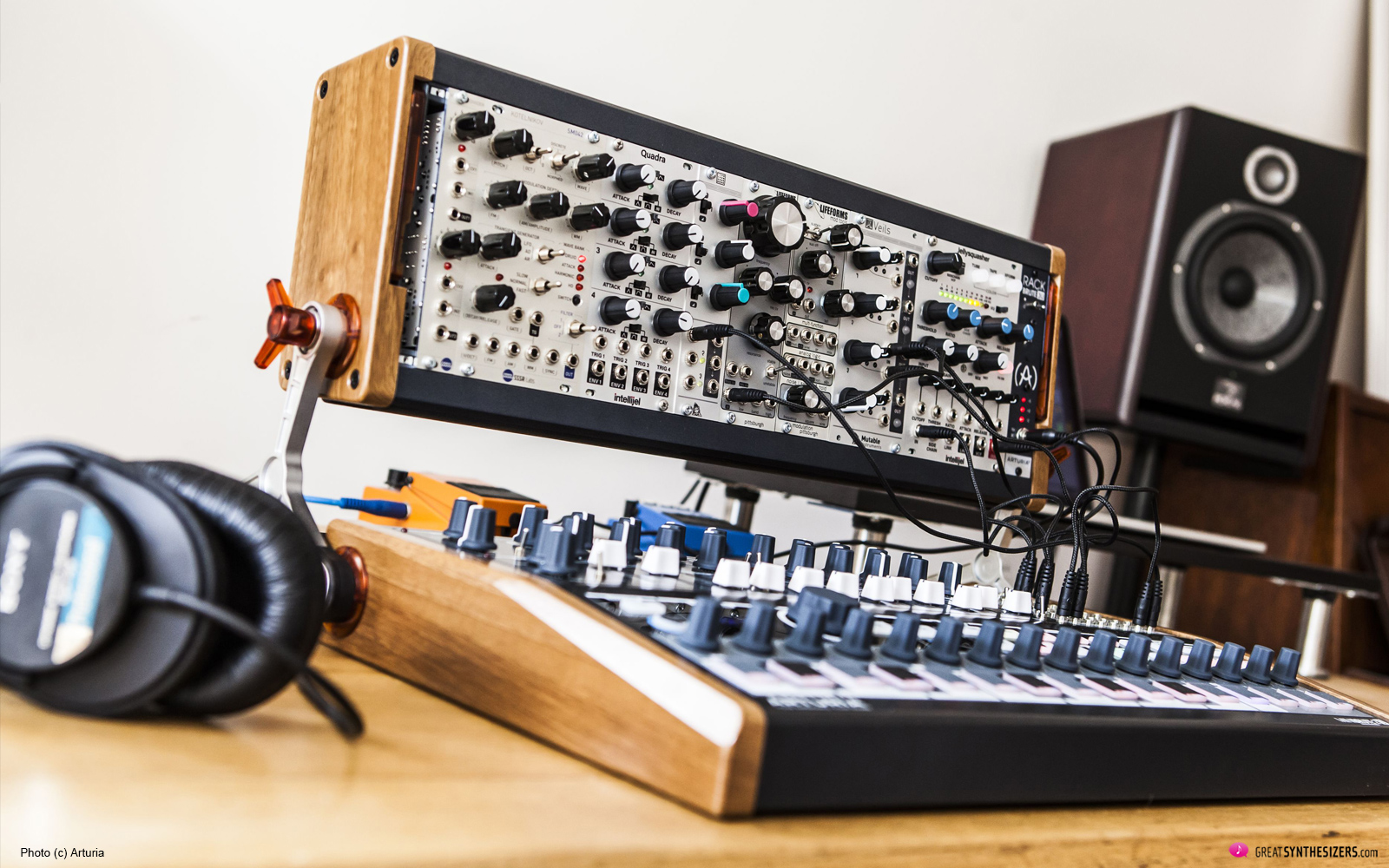


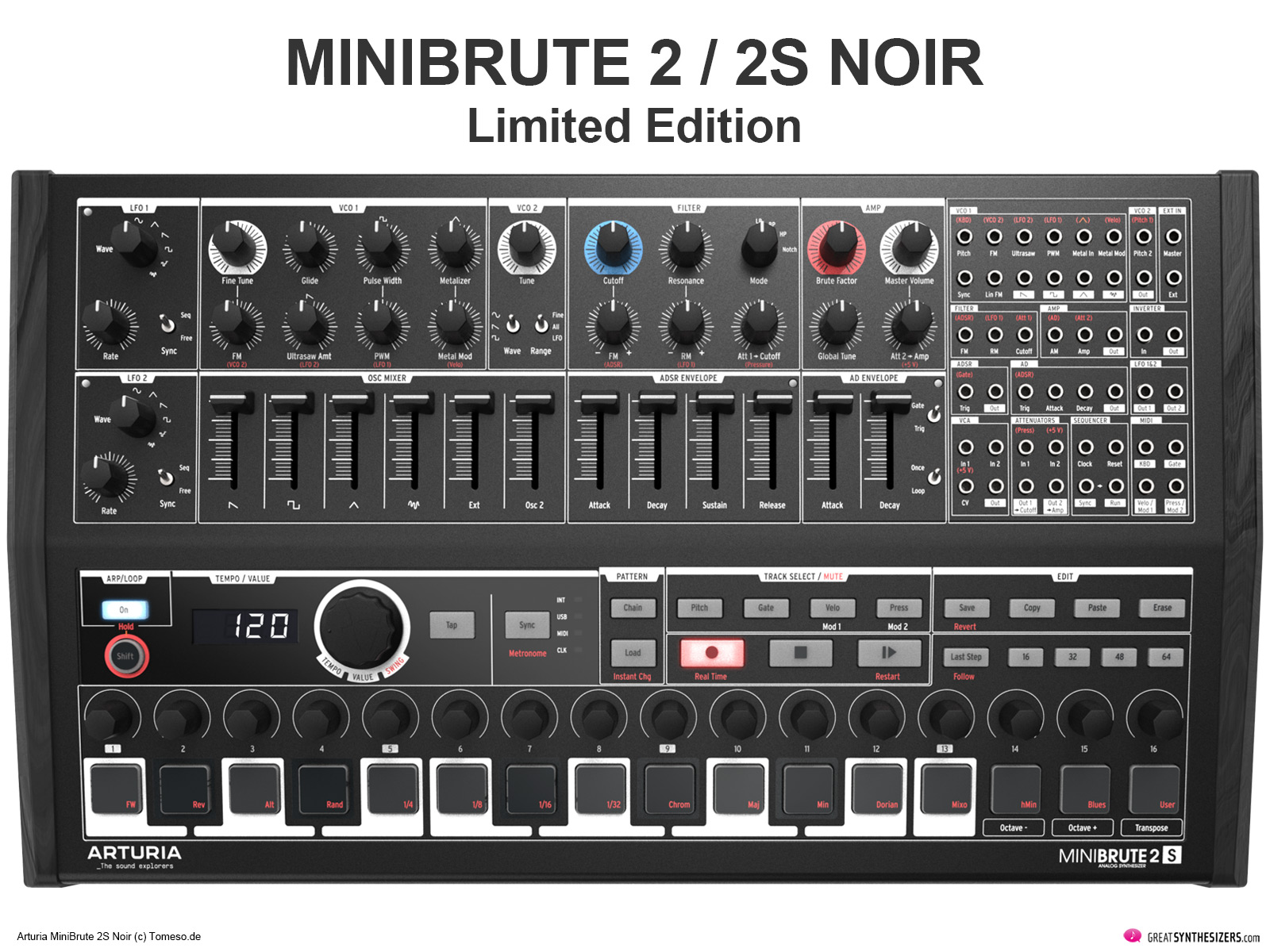

MiniBrute 2 can do ring modulation using the extra VCA. One oscillator into VCA in, the other into CV in of the VCA. So it does have ring modulation.
… thanks for the note, Locosynth.
Great write-up Theo. It is indeed a funny time in the synth world where “semi-modular analog” is everywhere. I actually wrote-up a little thing on the original Minibrute the other day. I actually think that is the real people’s number 1 analog, as you put it. It’s still unparalleled in terms of form and function (and connectivity). The Novation BS2 might get an honorable mention but you lose a lot of the MB’s 1:1 functionality along with the cv/gate connectivity.
I think the problem with the MB2 is actually too many options (the Matrixbrite even more so). I would have loved an updated MB with 2nd oscillator, ring mod, FM, but without the patch bay. Semi-modular connectivity is tricky to get right and feels less useful these days when real modular is so cheap. I think manufacturers will do better in the long run if they stick to preset/normalized routings with “just enough” CV/Gate connections (e.g., MB, Dark Energy) to allow it to work with the outside world without creating “option overload” for the user. My 2c!